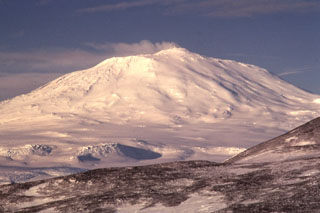Report on Erebus (Antarctica) — May 1979
Scientific Event Alert Network Bulletin, vol. 4, no. 5 (May 1979)
Managing Editor: David Squires.
Erebus (Antarctica) Lava lake and Strombolian activity persist
Please cite this report as:
Global Volcanism Program, 1979. Report on Erebus (Antarctica) (Squires, D., ed.). Scientific Event Alert Network Bulletin, 4:5. Smithsonian Institution. https://doi.org/10.5479/si.GVP.SEAN197905-390020
Erebus
Antarctica
77.53°S, 167.17°E; summit elev. 3794 m
All times are local (unless otherwise noted)
The following is excerpted from Kyle (1979). "An average of 1.6 eruptions per day occurred during December 1978, compared to 3.6/day in January 1978 and an average of about 2.5 eruptions daily between December 1972 and January 1976.
"During an attempt on 23 December 1978 by a joint U.S.-New Zealand team to get a member into the Inner Crater, an eruption occurred from a small vent (termed the active vent) adjacent to the lava lake. Lava was observed to rise rapidly in the active vent, and as it reached the rim the explosion occurred. At the time of the eruption, New Zealand volcanologist W.F. Giggenbach had descended to ~25 m above the Inner Crater floor. One small bomb hit him above his knee, burning his woolen pants but causing no injury. Other bombs rose ~200 m above the Main Crater rim, many landing on the Main Crater floor. After the eruption there was a drop in the general level of the lava lake, which returned to its original level in about 15 minutes. It is believed that a subterranean connection exists between the active vent and the lava lake.
"The overall pattern of activity at Mt. Erebus is unchanged. The small Strombolian eruptions are likely to continue as long as the active vent is open and connected to the main magma column. Since 1976 there has been no increase in the size of the lava lake; collapse of the N crater wall has probably reduced the overall size. It is apparent from observations made inside the Inner Crater that the lava is perched above the floor in the Inner Crater. A ridge and small levee retain the lava to the N half of the Inner Crater."
Reference. Kyle, P.R., 1979, Volcanic activity of Mt. Erebus, 1978/79: Antarctic Journal of the United States, v. 14, no. 5, p. 35-36.
Geological Summary. Mount Erebus, the world's southernmost historically active volcano, overlooks the McMurdo research station on Ross Island. It is the largest of three major volcanoes forming the crudely triangular Ross Island. The summit of the dominantly phonolitic volcano has been modified by one or two generations of caldera formation. A summit plateau at about 3,200 m elevation marks the rim of the youngest caldera, which formed during the late-Pleistocene and within which the modern cone was constructed. An elliptical 500 x 600 m wide, 110-m-deep crater truncates the summit and contains an active lava lake within a 250-m-wide, 100-m-deep inner crater; other lava lakes are sometimes present. The glacier-covered volcano was erupting when first sighted by Captain James Ross in 1841. Continuous lava-lake activity with minor explosions, punctuated by occasional larger Strombolian explosions that eject bombs onto the crater rim, has been documented since 1972, but has probably been occurring for much of the volcano's recent history.
Information Contacts: P. Kyle, Ohio State Univ.

